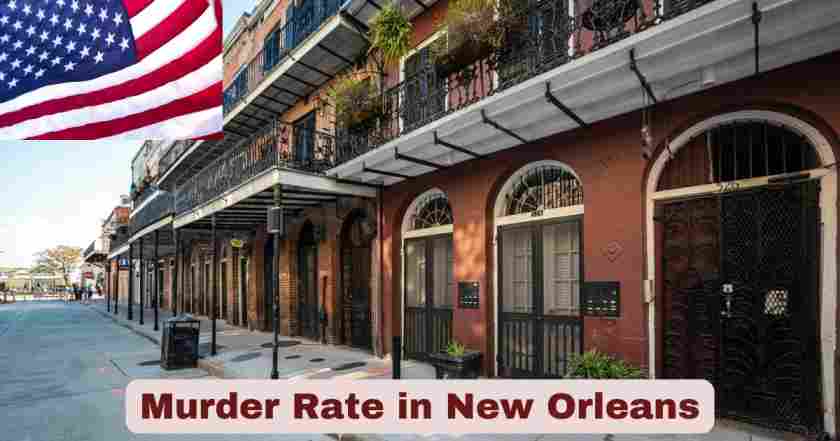Murder Rate in New Orleans 2025
New Orleans is experiencing one of the most dramatic transformations in public safety witnessed in any major American city during recent years. After decades of struggling with violent crime and earning the unfortunate designation as one of the nation’s most dangerous cities, the Crescent City has achieved remarkable progress in reducing homicides. The city that once held the dubious distinction of being America’s murder capital is now on track to record its lowest number of killings since the early 1970s, representing a fundamental shift in the trajectory of violent crime.
The story of New Orleans in 2025 is one of unexpected hope and sustained effort. Through a combination of strategic policing initiatives, enhanced federal partnerships, community engagement programs, and data-driven enforcement strategies, the city has managed to reduce its murder rate by extraordinary margins. Law enforcement officials, community leaders, and residents alike are cautiously optimistic that these improvements represent lasting change rather than temporary fluctuations in crime patterns. The comprehensive approach to violence reduction, which addresses both immediate threats and underlying social factors, has created conditions for sustained improvement in public safety outcomes across neighborhoods that have historically experienced high levels of violence.
Key Stats & Facts About Murder Rate in New Orleans 2025
| Category | Statistics & Details |
|---|---|
| Total Murders Through Mid-2025 | 55 homicides recorded as of July 14, 2025 (including 14 victims from January 1 terrorist attack) |
| Murder Rate Decline | 34% decrease compared to same period in 2024; 27% reduction in first half of 2025 vs. first half 2024 |
| 12-Month Rolling Murder Count | 102 murders in rolling 12-month period as of mid-2025 (down from 266 in February 2023 peak) |
| Projected Annual Total 2025 | On pace for approximately 100-110 murders annually (lowest since early 1970s) |
| 2024 Full Year | 124 homicides (35% decrease from 192 in 2023) |
| Historical Peak | 265 murders in 2022 (post-Katrina high) |
| Historical Low (Recent) | 120 murders in 2019 (47-year low before pandemic surge) |
| Homicide Clearance Rate | 90% arrest rate for murder cases (“9 out of 10 chance” perpetrators arrested) |
| Violent Crime Overall | 20% decrease year-over-year in total violent crime incidents in 2025 |
| Non-Fatal Shootings | 44% reduction in 2024; 28% decrease in first months of 2025 |
Data Source: New Orleans Police Department (NOPD) Analytics Unit, AH Datalytics Crime Analysis, NOPD 2024 Annual Crime Report
The numbers presented in this table reflect the most recent data available from official law enforcement sources and independent crime analysis organizations that work directly with NOPD data. The dramatic reductions across multiple categories of violent crime demonstrate that New Orleans has achieved some of the most significant improvements in public safety seen in any major American city. The 55 murders recorded through mid-July 2025 represents one of the lowest totals at this point in the year since the 1960s, particularly notable given that this figure includes the 14 fatalities from the New Year’s Day terrorist attack on Bourbon Street.
The rolling 12-month murder count of 102 homicides marks a watershed moment for the city. This represents a decline of more than 60% from the peak of 266 murders recorded in the 12-month period ending in February 2023. To put this in context, during the height of the post-pandemic crime surge, New Orleans was experiencing an average of more than one murder every 33 hours. The current rate has improved to approximately one murder every 86 hours based on the rolling 12-month data, representing a fundamental shift in the frequency of lethal violence. Crime analysts have identified that the sustained reduction began around February 2023 and has continued through multiple administrations and policy changes, suggesting the improvements stem from deep structural changes rather than temporary enforcement surges.
Comparison of Murder Statistics in the US 2025 with Historical New Orleans Data
| Year | Total Murders | Year-Over-Year Change | Notable Context |
|---|---|---|---|
| 2025 (Projected) | 100-110 | -11% to -19% | Lowest since early 1970s; includes January 1 terrorist attack (14 victims) |
| 2024 | 124 | -35% | Dramatic single-year reduction; federal task force operational |
| 2023 | 192 | -28% | Beginning of sustained decline; Troop NOLA deployment started |
| 2022 | 265 | +9% | Post-Katrina peak; New Orleans reclaimed “murder capital” designation |
| 2021 | 244 | +104% | Pandemic-era surge continued |
| 2020 | 195 | +63% | Pandemic impact began; social disruption widespread |
| 2019 | 120 | -24% | 47-year low; pre-pandemic baseline |
| 2018 | 158 | -16% | Continued improvement from previous years |
Data Source: New Orleans Police Department Annual Reports, FBI Uniform Crime Reporting Program, AH Datalytics Historical Crime Analysis
This historical comparison reveals the dramatic volatility New Orleans experienced in murder rates over recent years. The city achieved a remarkable 47-year low of 120 murders in 2019, only to see violence more than double during the pandemic years, reaching 265 murders in 2022. This represented one of the steepest increases in violent crime experienced by any major American city during this period. The 2022 peak was particularly alarming because it exceeded even the violent years immediately following Hurricane Katrina, when the city was struggling with displacement, economic disruption, and weakened social infrastructure.
The reversal that began in 2023 has proven equally dramatic but in the opposite direction. The 28% reduction from 2022 to 2023 represented the beginning of what would become a sustained trend. The 35% decrease from 2023 to 2024 marked the most significant single-year improvement in the city’s modern history. The projected figures for 2025, showing another 11-19% reduction depending on how the remainder of the year unfolds, would represent three consecutive years of substantial decline. This pattern suggests the improvements are not merely statistical fluctuations but reflect fundamental changes in enforcement strategies, community dynamics, and violence intervention programs.
The 2025 projection of 100-110 murders carries additional significance given that this total includes the 14 victims of the January 1 terrorist attack on Bourbon Street. Without this mass casualty incident, which was distinct from the typical patterns of urban violence, the city would be on pace for approximately 86-96 homicides for the year. This would represent a 60% reduction from the first half of 2024, as noted by law enforcement officials, and would position New Orleans at murder levels not seen since the early 1970s when the city had significantly different demographic and geographic characteristics.
Violent Crime Categories in New Orleans
| Crime Category | 2025 Change (YTD) | 2024 Annual Change | Current Status |
|---|---|---|---|
| Armed Robbery | -13.9% | -41% | Significant decline from peak years |
| Unarmed Robbery | -28.8% | Data unavailable | Substantial improvement |
| Carjackings | -33% | -66% | Dramatic reduction; was epidemic in 2021-2022 |
| Non-Fatal Shootings | -28% | -44% | Indicates reduction in gun violence beyond homicides |
| Auto Theft | -48.6% | Data unavailable | One of largest percentage decreases |
| Rape/Sexual Assault | -3.9% | +25% | Only major violent crime category with recent increases |
| Aggravated Assault | -16% | Data unavailable | Contributing to overall violent crime reduction |
Data Source: NOPD Analytics Unit Monthly Reports, NOPD 2024 Annual Crime Report, Axios New Orleans Crime Analysis
The reductions in violent crime categories beyond murder demonstrate that New Orleans is experiencing broad-based improvements in public safety rather than narrow gains in a single area. The 48.6% decrease in auto theft represents one of the most dramatic improvements, addressing a crime that had reached epidemic levels during the pandemic years when organized theft rings were operating with relative impunity. Similarly, the 33% reduction in carjackings has had enormous psychological impact on residents who had become fearful of being targeted at stoplights or in parking areas.
The 28% decline in non-fatal shootings carries particular significance for crime analysts because shootings are considered a leading indicator of future homicide trends. The fact that shooting incidents have decreased at nearly the same rate as murders suggests the violence reduction is comprehensive rather than reflecting changes in medical response that might save more shooting victims. The 44% reduction in non-fatal shootings achieved in 2024 represented a turning point, as it indicated that gun violence was being addressed at its source rather than simply better treatment outcomes for victims.
The armed robbery reduction of 41% in 2024 and continued 13.9% decrease in 2025 reflects improved deterrence and faster response times. Law enforcement officials attribute this partly to increased police presence in commercial districts and enhanced surveillance technologies that make robbery attempts riskier for perpetrators. The even larger 28.8% decline in unarmed robberies suggests that overall criminal opportunity structures have been disrupted through coordinated enforcement efforts.
However, the data reveals a concerning exception to the positive trends. Rape and sexual assault cases increased 25% in 2024 after years of suspected underreporting. While 2025 has shown a 3.9% decrease, the New Orleans Police Department faced criticism for systematically underreporting rape cases in previous years. Advocates discovered that NOPD had been incorrectly classifying many sexual assault reports, leading to forced corrections of two years of data. The 7% clearance rate for rape cases reported to the FBI for 2024 places New Orleans near the bottom among U.S. cities with populations over 100,000, indicating this remains an area requiring significant improvement in investigative capacity and victim support services.
Factors Contributing to Murder Rate Reduction in New Orleans 2025
| Contributing Factor | Description & Impact | Implementation Timeline |
|---|---|---|
| Troop NOLA Deployment | Louisiana State Police dedicated unit patrolling New Orleans streets; added state resources to local enforcement | Operational since mid-2024 |
| Federal Task Force Partnership | Joint operations with ATF, Homeland Security Investigations; 85 guns seized, 45 felons arrested for illegal possession | Announced May 2025; ongoing operations |
| Enhanced Clearance Rates | 90% arrest rate for murders; improved investigative quality and evidence presentation | Continuous improvement 2023-2025 |
| Detective James Fyfe | Homicide detective with exceptional solve rates; district attorney calls him “rock star” for case file quality | Began homicide work in 2022 |
| COVID Relief Funding | Federal pandemic relief invested in infrastructure improvements, street lighting, job programs | Deployed 2022-2024 |
| Violence Intervention Programs | Ubuntu Village, Violence Intervention Program, Trauma Recovery Center providing community support | Expanded funding 2023-2025 |
| Data-Driven Policing | Predictive deployment strategies; analytics-based resource allocation despite officer shortages | Implemented under NOPD reforms |
| Office of Violence Prevention | Public health approach to violence; trauma-informed community interventions | Operational under Health Department |
Data Source: NOPD Press Conferences, Orleans Parish District Attorney Reports, Louisiana State Police Operations Data, City of New Orleans Health Department
The remarkable reduction in New Orleans murder rate stems from multiple interconnected factors rather than any single intervention. Troop NOLA, the dedicated Louisiana State Police unit, brought additional patrol capacity to a police department that has consistently operated below optimal staffing levels. With approximately 898 commissioned officers, NOPD has maintained effective coverage through strategic deployment guided by crime analytics rather than traditional beat assignments. The state police supplementation has allowed more aggressive patrolling in identified hot spots while maintaining response capacity across the city.
The federal task force partnership announced in May 2025 has demonstrated immediate impact. In just the first months of operation, federal agents working alongside NOPD seized 85 firearms, with 17 reported stolen, and confiscated substantial quantities of drugs including 1.5 pounds of methamphetamine, 601 grams of crack cocaine, and 221 grams of heroin. Perhaps most significantly, 45 individuals were arrested for felony possession of firearms, removing repeat offenders from circulation. District Attorney Jason Williams emphasized that these arrests target major drug dealers and gun traffickers whose activities fuel street-level violence, and Louisiana’s strict sentencing laws mean those possessing over 28 grams of controlled substances face mandatory minimum sentences of at least 10 years.
The transformation in investigative quality represents another critical factor. Detective James Fyfe, who began working homicides in 2022, has achieved solve rates that district attorney staff describe as unprecedented. His case files are so thoroughly documented that prosecution becomes substantially easier, contributing to the overall 90% clearance rate for murders. This means that in today’s New Orleans, there is a 9 out of 10 chance that anyone who commits murder will be arrested, a dramatic deterrent compared to the lower clearance rates that prevailed during the peak violence years when investigations were overwhelmed.
The investment of COVID relief funding in infrastructure improvements has created indirect but meaningful impacts on crime. Enhanced street lighting in previously dark areas is known to reduce violent crime by eliminating concealment opportunities and increasing natural surveillance. Job programs created with federal funds have provided employment opportunities for at-risk individuals, particularly young men who statistically represent both the primary perpetrators and victims of urban violence. These structural improvements address root causes of violence rather than merely responding to criminal acts after they occur.
Geographic Distribution of Murders in New Orleans 2025
| Area/District | Crime Level Changes | Contributing Factors |
|---|---|---|
| French Quarter | Improved safety despite January 1 terrorist attack; enhanced federal presence post-attack | Tourism focus; concentrated law enforcement |
| Central City | Significant reductions from peak years; historically high-crime area showing improvement | Targeted interventions; community programs |
| Central Business District | Enhanced security; lower crime rates benefiting from downtown focus | Business improvement districts; private security coordination |
| Magnolia Projects Area | Major gang enforcement operations; 10 arrests of M3 gang members in March 2025 | Focused gang suppression efforts |
| Seventh Ward | Historical violence hotspot showing improvement with broader city trends | Community engagement; violence interrupters |
| New Orleans East | Varying outcomes by specific neighborhood; some areas significant improvement | Geographic spread requires different strategies |
| Lakeview | Consistently lower crime; minimal impact from city-wide violence trends | Higher-income area; different demographic patterns |
| Algiers | West Bank area with independent dynamics; improvements mirror overall city trends | Cross-river location; distinct community factors |
Data Source: NOPD District-Level Crime Data, Metrocrime Weekly Crime Bulletin Geographic Analysis, City Council Crime Dashboard
The geographic distribution of murder rate improvements across New Orleans reveals that reductions have occurred broadly rather than concentrated in specific neighborhoods. Areas like Central City that historically experienced the highest levels of violence have seen some of the most significant percentage decreases, suggesting that enforcement strategies have successfully targeted the locations with greatest need. The Magnolia Projects area, long associated with gang activity, saw focused enforcement in March 2025 when NOPD arrested 10 individuals affiliated with the Magnolia “M3” gang, disrupting organized criminal operations that had been driving violence.
The French Quarter, despite experiencing the tragic terrorist attack on January 1, 2025 that claimed 14 lives, has otherwise maintained improved safety conditions. The attack was an anomaly unrelated to typical urban crime patterns, and the federal response brought enhanced security presence that has benefited overall safety. Tourist areas have been particular priorities for law enforcement given their economic importance to the city, and the combination of NOPD, Louisiana State Police, and federal agents has created visible deterrence.
Neighborhood-level analysis by crime data company AH Datalytics indicates that property crimes and violent offenses have declined even in areas where residents have historically complained about chronic crime problems. This suggests the improvements extend beyond the most visible tourist and commercial areas into residential neighborhoods where quality of life had been degraded by persistent criminal activity. However, disparities remain, with some neighborhoods continuing to experience disproportionate violence while others see minimal crime impact.
Law Enforcement Staffing and Resources in New Orleans
| Resource Category | Current Status | Impact on Operations |
|---|---|---|
| NOPD Commissioned Officers | 898 officers (below optimal staffing levels) | Strategic deployment compensates for shortage |
| Troop NOLA Personnel | Dedicated Louisiana State Police unit; specific numbers not publicly disclosed | Significant supplemental capacity |
| Federal Agents | ATF, Homeland Security Investigations task force members; rotating assignments | Specialized expertise and resources |
| Gun Seizures 2025 | 1,501 firearms seized through October (18% decrease from 1,827 in same period 2024) | Lower seizures partly reflect reduced gun crime |
| Illegal Gun Possession Arrests | 215 arrests for illegal firearm possession through October (41% decrease from 364 in 2024) | Reflects both enforcement success and deterrence |
| Federal Oversight | Ongoing consent decree mandating reforms; constitutional policing standards | Ensures accountability and professional standards |
| Crime Analytics Unit | NOPD department providing data-driven deployment strategies | Enables efficient use of limited personnel |
Data Source: NOPD Official Statements, Louisiana State Police Reports, NOPD 2025 Year-to-Date Statistics
Despite achieving remarkable crime reductions, the New Orleans Police Department continues operating with 898 commissioned officers, well below the levels considered optimal for a city of this size and geographic spread. The department has compensated for this persistent shortage through data-driven deployment strategies developed by its Analytics Unit, which uses crime pattern analysis to position officers where they can have maximum impact. This precision-based approach, as Superintendent Anne Kirkpatrick describes it, focuses resources on identified hot spots and times when violence is most likely to occur rather than spreading personnel thinly across all areas.
The 41% decrease in arrests for illegal firearm possession, from 364 arrests in the January-October 2024 period to 215 arrests in the same period of 2025, reflects the complex dynamics of successful crime reduction. While fewer arrests might initially seem negative, law enforcement officials interpret this partly as evidence of deterrence—fewer people are carrying illegal guns because enforcement has made this behavior riskier. Similarly, the 18% reduction in firearms seized, from 1,827 guns to 1,501 guns, correlates with reduced gun violence overall.
The federal oversight through a consent decree, while sometimes viewed as burdensome by police officials, has mandated reforms that have improved investigative quality and community relations. The enhanced reporting standards, constitutional policing requirements, and accountability measures have contributed to the improved clearance rates and case quality that make prosecution more successful. District Attorney Jason Williams has specifically praised the improved “work product” from investigations, noting that case files under both former Interim Superintendent Michelle Woodfork and current Superintendent Kirkpatrick have been substantially better than in previous years.
National Context: Murder Rate in the US 2025 Comparison with Other Cities
| City | Murder Rate Trend | 2025 Context |
|---|---|---|
| New Orleans | -34% YTD 2025; projected 100-110 total murders | Dramatic improvement from being murder capital |
| St. Louis, Missouri | -45% through Q1 2025; continuing multi-year decline | Among highest rates but improving |
| Baltimore, Maryland | Second highest murder rate nationally at 51.1 per 100,000 in recent data | Persistent challenges despite some improvements |
| Detroit, Michigan | 203 homicides in 2024 (lowest since 1965); -19% from 2023 | Historic lows after decades of high violence |
| Memphis, Tennessee | 40.9 murders per 100,000 in 2023; among national leaders | Shelby County saw largest rate increase 2018-2023 |
| Chicago, Illinois | Improvements continuing; Illinois statewide rate 6 per 100,000 | Political focus despite relative improvement |
| Las Vegas, Nevada | -21% murders in 2024; continuing decline into 2025 | Improvement in major tourist destination |
| National Average | 5 per 100,000 residents nationally; projected to be lowest recorded rate ever in 2025 | Broader trend of crime reduction |
Data Source: FBI Uniform Crime Reporting Program, CDC WONDER Database, City Police Department Reports, USAFacts Crime Data Analysis
The improvements in New Orleans murder rate must be understood in the context of broader national trends showing declining violence across many major cities. Crime analyst Jeff Asher notes that 2025 may achieve the lowest U.S. murder rate ever recorded, a remarkable turnaround just five years after the largest murder increase ever documented occurred in 2020. New Orleans’ 34% year-over-year reduction substantially exceeds the national 12% decline in murders, suggesting that local factors and targeted interventions are driving change beyond the broader social forces affecting all cities.
St. Louis has achieved a 45% reduction in homicides through the first quarter of 2025, representing one of the steepest declines among major cities. Like New Orleans, St. Louis had experienced extremely high murder rates in recent years and is now seeing the benefits of sustained enforcement and intervention efforts. Detroit recorded 203 murders in 2024, its lowest total since 1965, demonstrating that even cities with long histories of high violence can achieve fundamental change through persistent effort.
However, not all cities have seen such dramatic improvements. Baltimore continues to maintain the second-highest murder rate in the nation at 51.1 murders per 100,000 residents, and Memphis recorded a rate of 40.9 per 100,000 in 2023. Orleans Parish (coterminous with New Orleans) saw a 15.2 per 100,000 increase from 2018 to 2023, representing the third-largest increase nationally during that period, though the subsequent decline has reversed much of that surge.
The national context also reveals political dimensions to crime discussions. While Chicago receives substantial attention as a “killing field” in national political rhetoric, Illinois’ statewide homicide rate of 6 per 100,000 ranks only 20th nationally. Meanwhile, Louisiana as a whole maintains a rate of 9 per 100,000, ranking fourth nationally, driven partly by violence in smaller cities like Shreveport and Baton Rouge. This illustrates that violent crime is not exclusively an urban or political phenomenon but reflects complex regional patterns influenced by socioeconomic factors, gun availability, and local governance capacity.
Challenges and Limitations Despite Murder Rate Improvements in the US 2025
| Persistent Challenge | Current Status | Required Actions |
|---|---|---|
| Rape Investigation and Clearance | 7% clearance rate for 2024; near bottom nationally | Specialized training; victim support services; investigative capacity |
| Domestic Violence | Decreased 40% in 2024 but remains concern | Continued intervention programs; protection order enforcement |
| Mental Health Crises | Increasing calls requiring specialized response | Crisis intervention training; mental health professional partnerships |
| Neighborhood Disparities | Some areas still experience disproportionate violence | Targeted resources; community engagement in high-need areas |
| Police Staffing | 898 officers below optimal levels | Recruitment challenges; retention strategies; competitive compensation |
| Long-Term Sustainability | Concern about maintaining gains with potential administration changes | Institutionalizing successful programs; community ownership |
| Economic Inequality | Underlying poverty rate 22.63% contributes to violence | Job creation; education access; economic development |
| Gun Availability | Continued circulation of illegal firearms despite seizures | Regional cooperation; trafficking interdiction; source investigation |
Data Source: NOPD 2024 Annual Report, Federal Bureau of Investigation Crime Data, New Orleans Health Department, Economic Research Data
Even as New Orleans celebrates historic reductions in its murder rate, significant challenges persist that could undermine long-term progress. The 7% clearance rate for rape cases represents a crisis of investigative capacity and victim support. When only one in fourteen rape cases results in an arrest, it creates an environment where sexual predators operate with near-impunity while victims feel unsupported by the justice system. The previous underreporting scandal, where NOPD incorrectly classified sexual assault reports for years, has damaged community trust that will require sustained effort to rebuild.
Neighborhood disparities in crime and police services remain pronounced. While overall city statistics show dramatic improvement, some communities continue experiencing violence at levels that prevent normal life. Residents in these areas face the psychological trauma of gunfire, the economic costs of businesses refusing to locate in their neighborhoods, and the social disruption of losing young men to violence and incarceration. Achieving citywide improvement while leaving specific neighborhoods behind creates both moral and practical problems, as concentrated disadvantage tends to regenerate violence even as surrounding areas stabilize.
The police staffing shortage represents a structural limitation on sustaining progress. With 898 commissioned officers serving a city of approximately 351,000 residents spread across a large geographic area, NOPD relies heavily on strategic deployment and supplementation from state police and federal agents. If these supplemental resources were withdrawn or if officer numbers declined further through attrition, maintaining current crime levels could become difficult. Police work remains physically demanding and psychologically stressful, particularly in high-crime environments, making recruitment and retention perpetual challenges.
Community leaders like Ernest Johnson of Ubuntu Village have cautioned that the improvements cannot be taken for granted, particularly with a mayoral election adding uncertainty about whether the next administration will maintain current strategies. Johnson noted, “We can’t allow trends to dictate our sustainability,” emphasizing that short-term success must be translated into long-term institutional capacity and community resilience. The heavy reliance on enhanced law enforcement presence, while effective in reducing immediate violence, must eventually be complemented by addressing root causes like poverty (affecting 22.63% of the population), educational inequality, and limited economic opportunities.
Future Outlook
New Orleans stands at a critical juncture in its relationship with violent crime. The city has demonstrated that dramatic reductions in homicide are achievable through coordinated law enforcement strategies, federal partnerships, and community engagement. The projected 100-110 murders for 2025 would represent the lowest annual total in approximately five decades, a remarkable achievement for a city that just three years ago held the unenviable distinction of being America’s murder capital. The sustained nature of improvements across three consecutive years suggests these gains reflect fundamental changes rather than temporary fluctuations.
However, the path forward requires vigilance and continued investment. The success factors that drove crime reductions—enhanced federal support, state police supplementation, improved investigative quality, and community programs—all require sustained funding and political commitment. Economic pressures, changing political priorities, or complacency could undermine progress if stakeholders assume the problem has been solved. The persistent challenges in areas like sexual assault investigation, neighborhood disparities, and police staffing demonstrate that public safety transformation remains incomplete. For New Orleans to truly move beyond its violent past, the current momentum must be maintained while simultaneously addressing the underlying social and economic conditions that create vulnerability to violence. The coming years will determine whether 2025 marks a turning point toward lasting safety or merely a temporary respite in a longer cycle of violence.
Disclaimer: The data research report we present here is based on information found from various sources. We are not liable for any financial loss, errors, or damages of any kind that may result from the use of the information herein. We acknowledge that though we try to report accurately, we cannot verify the absolute facts of everything that has been represented.







